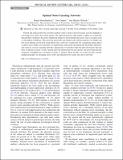| dc.contributor.author | Wilczek, Michael | |
| dc.contributor.author | Ronellenfitsch, Henrik Michael | |
| dc.contributor.author | Dunkel, Joern | |
| dc.date.accessioned | 2018-11-20T20:16:21Z | |
| dc.date.available | 2018-11-20T20:16:21Z | |
| dc.date.issued | 2018-11 | |
| dc.date.submitted | 2018-07 | |
| dc.identifier.issn | 0031-9007 | |
| dc.identifier.issn | 1079-7114 | |
| dc.identifier.uri | http://hdl.handle.net/1721.1/119241 | |
| dc.description.abstract | Natural and artificial networks, from the cerebral cortex to large-scale power grids, face the challenge of converting noisy inputs into robust signals. The input fluctuations often exhibit complex yet statistically reproducible correlations that reflect underlying internal or environmental processes such as synaptic noise or atmospheric turbulence. This raises the practically and biophysically relevant question of whether and how noise filtering can be hard wired directly into a network’s architecture. By considering generic phase oscillator arrays under cost constraints, we explore here analytically and numerically the design, efficiency, and topology of noise-canceling networks. Specifically, we find that when the input fluctuations become more correlated in space or time, optimal network architectures become sparser and more hierarchically organized, resembling the vasculature in plants or animals. More broadly, our results provide concrete guiding principles for designing more robust and efficient power grids and sensor networks. | en_US |
| dc.publisher | American Physical Society | en_US |
| dc.relation.isversionof | http://dx.doi.org/10.1103/PhysRevLett.121.208301 | en_US |
| dc.rights | Article is made available in accordance with the publisher's policy and may be subject to US copyright law. Please refer to the publisher's site for terms of use. | en_US |
| dc.source | American Physical Society | en_US |
| dc.title | Optimal Noise-Canceling Networks | en_US |
| dc.type | Article | en_US |
| dc.identifier.citation | Ronellenfitsch, Henrik, et al. “Optimal Noise-Canceling Networks.” Physical Review Letters, vol. 121, no. 20, Nov. 2018. © 2018 American Physical Society | en_US |
| dc.contributor.department | Massachusetts Institute of Technology. Department of Mathematics | en_US |
| dc.contributor.mitauthor | Ronellenfitsch, Henrik Michael | |
| dc.contributor.mitauthor | Dunkel, Joern | |
| dc.relation.journal | Physical Review Letters | en_US |
| dc.eprint.version | Final published version | en_US |
| dc.type.uri | http://purl.org/eprint/type/JournalArticle | en_US |
| eprint.status | http://purl.org/eprint/status/PeerReviewed | en_US |
| dc.date.updated | 2018-11-16T18:00:19Z | |
| dc.language.rfc3066 | en | |
| dc.rights.holder | American Physical Society | |
| dspace.orderedauthors | Ronellenfitsch, Henrik; Dunkel, Jörn; Wilczek, Michael | en_US |
| dspace.embargo.terms | N | en_US |
| dc.identifier.orcid | https://orcid.org/0000-0002-7799-3368 | |
| dc.identifier.orcid | https://orcid.org/0000-0001-8865-2369 | |
| mit.license | PUBLISHER_POLICY | en_US |
